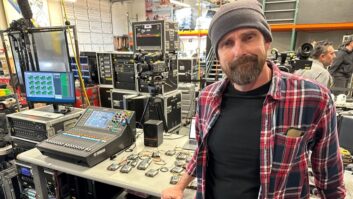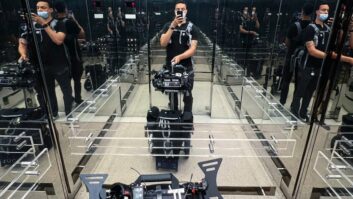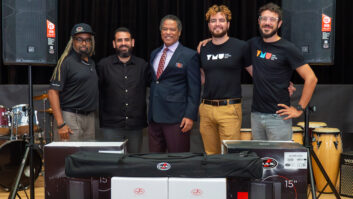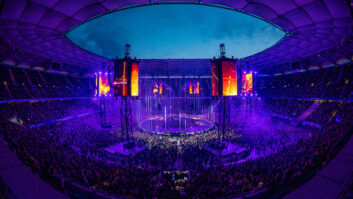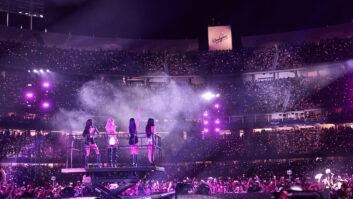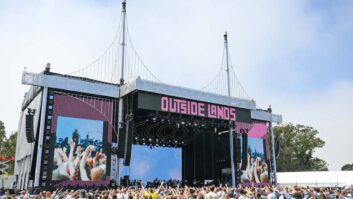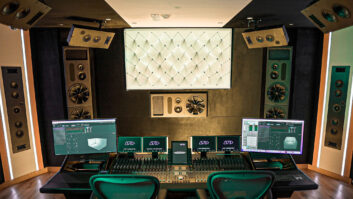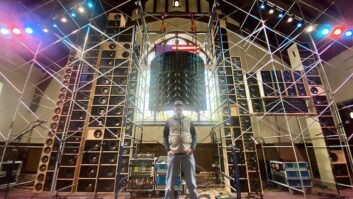
Two down, one to go. Director Peter Jackson’s take on The Lord ofthe Rings trilogy is a spectacularly ambitious undertaking: threefilms, each well over two hours, released just a year apart. They wereshot all at once in Jackson’s native New Zealand two years ago, but theposting and extensive visual effects work (also mostly in New Zealand)has been going on ever since, and will occupy dozens of people’s daysuntil next December, when the final episode is released.
For the sound post-production crew, the latest installment, TheTwo Towers, was an opportunity to build on the sonic foundationcreated for The Fellowship of the Ring and to refine ideas andsystems. The team that brought the sounds of Middle Earth sobrilliantly to life — and earned an Oscar nomination in theprocess — was largely intact for The Two Towers, includingsound designer David Farmer, supervising sound editors Ethan Van derRijn and Mike Hopkins, and re-recording mixers Christopher Boyes (leadmixer and effects), Michael Semanick (dialog), Michael Hedges (music)and others. This time around, Boyes also brought in Gary Summers tohelp him with the Herculean premix. Post work took place at the FilmUnit in Wellington, New Zealand, using an assortment of platforms,ranging from the Euphonix System 5 to Pro Tools (the choice of thesound editors) to Tascam MMR8s.
“Having the library of sounds from the first film was afantastic place to start from when we began working on film two,”says Van der Rijn. “We were able to really focus on the areas ofthe film that were entirely new: locations, winds, tree talk, andmovement and sounds for massed Uruk-hai marching and chanting, etc. Wewere also able to deepen some sections of the library, which we alreadyhad a really good basis for, such as all of the combat sounds, as wellas the initial vocal palettes for the Orcs and Uruk-hai.”
“Having done the first film,” notes Boyes (who won anOscar last year for his work on another “small” film,Pearl Harbor, and had won previously for Titanic),“we went into film two knowing more about the likes and dislikesof the director: his way of working, his preferences and knowing whatkind of stylistic approach he likes to take for certain scenes. Forinstance, we have a number of scenes where music is used to let theaudience experience the events in a more detached, less visceral way.In these scenes, effects are treated in such a way that they take on aghostly, echo-y quality — weaving in and out of the music as ifthey were swimming in the air around us. We used this approach on filmone in Boromir’s death, along with slow, dreamy visuals to stretch outtime and space. We returned to this style in film two; but this time,it also served as a way of taking the audience out of the head-onintensity of the battle for moments of time. In this way, it allowed usto shift the drama from individual events to a more massive globalevent and, at the same time, give the audience a rest sonically.
“The success of the first film had everything to do with theway the second one went,” Boyes adds. “It was a vote ofconfidence in us as a team that he was willing to let us start thefinal mix in his absence. When we started final mixing, he was stilltrying to finish [recording] Howard Shore’s score in London, so we setup a ‘polycom’: We had a TV monitor and a camera pointed atus, and he would have the same thing pointed at him in his hotel roomin London. We would send a computer file via a fat pipe — anultra-wideband Internet connection — and then he would sit at aPro Tools system with Genelecs and a video monitor and listen to ourpass at the final mix for any given reel. Then he would send us backhis ideas. It wasn’t a perfect situation, but better to have that thanflying blind or getting typewritten notes and not being able to see himdescribe what he wants. Of course, in the end, he came home and did hisfinal pass with us on the dub stage.
“Peter’s notes tended to be really clear and direct: ‘Iwant this scene to start really quiet and subtle and then build. I wantit to have this structure to it — we’re going somewhere withit,’” Boyes continues. “For instance, there’s a scenewhere the Uruk-hai are marching on Helm’s Deep, this fortress built upagainst a huge rock cliff, and they’re marching from afar, but thereare so many of them that they set up this incredible rhythmic pulse asthey’re marching. There were certain desires on the editorial team tohave that really be big and be felt and have this huge pulsing masscoming at you. And [Peter] came back and said, ‘No, this needs tobe subtle — so subtle that you feel the pulse, but you also hearthe breath of the warriors waiting for this oncoming army.’ Itwas a really poetic way to take it, and also, since that sceneprogresses into absolute chaos and mayhem, it was a great way to startbecause you’ve got something to build with.”
“What Peter articulated to us on the sound team in terms ofhis vision for the sound on film two was not so different from thatarticulated to us for film one,” Van der Rijn concludes.“Rather, it was a further deepening of certain themes andmotifs that we had started on film one. In many ways, this wholethree-film project feels like a voyage of discovery that the wholesound team is engaged in together with Peter.”

Helm’s Deep welcomes back Gimli and Legolas (of the fellowship, seen onthe white horse) and the brave knights who have just fought avictorious battles against a roaming band of orcs.

Fresh from the pits of Isengard, the second day of the battle at Helm’sDeep finds these Orcs storming the castle walls and continuing thebattle. A flurry of metal on metal as swords and other weapons clangtogether, coupled with the orc’s and man’s horrifying squeals andbattle cries, makes an explosive sound environment.

Traversing the wildness of Middle Earth, the Riders of Rohan ride awayfrom Helm’s Deep, after being cast away from King Theoden, who is nowunder Sauramon’s evil spell. An intriguing sound palette of horses’hooves, armor clanging and chainmail jingles against the actors’mics.

Additional Lord of the Rings quotes:
Lead re-recording mixer Chris Boyes on working at the Film Unitin Wellington, New Zealand:
“Early on, when we were starting Film One [The Fellowship of the Ring]we went around to various studios in Australia listening to the rooms,and we went to the Film Unit and listened to the room there and I justloved the sound of the room. At the time they had an analog Otari boardthat only had about 100 inputs and they were still based on magnatech,as well as 2-track tape, which doesn’t really work for the way we workthese days. So we put together a wish list along the lines of: all theeditors will be cutting on Pro Tools and therefore we’ll deliver to themix on Pro Tools and record onto MMR8 Tascam. We felt we needed adigital board with at least 200 inputs, and so we got the Euphonix[System 5]. What changed from last year to this year, and Film Two, isthey now have two dub rooms [at the Film Unit] and they took a sectionof the board we did Film One on and put it in the B room. Now, bothrooms match, so some sections of my automation could be called up inthe B room.”
Chris Boyes on the loudness of movies:
“Being the lead mixer and the effects mixer, I have to takeresponsibility for how loud the film gets. For me, Film One was alittle bit loud and I was determined to not let [The Two Towers] bequite that loud, and I hope that I succeeded. It’s a tough position tobe in-You’re faced with a film where every reel is as a big as thebiggest reel of a typical film, so it’s an amazing challenge. You can’tplease everybody, but at the end of the day there are two people youhave to please-the director and the audience. You don’t want to exhaustthe audience.”
Chris Boyes on the third installment of the trilogy:
“It’s going to be intense working on that film because by now we’vecreated this family. It’ll be an emotional time for the crew because wewill have gone through so much together. For me it will have been fouryears. Of course I go off and do other films when I’m not mixing, but alot of these guys-some of the editors are on it ten months a year. It’sbecome their lives, pretty much. So I think it’s natural that there’llbe a reluctance to let go. You become so fond and so passionate aboutthe product, you fall in love with it. That’s what I like about mybusiness-when you work on something like this it really becomes apersonal and emotional experience. Everybody’s going to want to finishit and make it as good as we can.”
